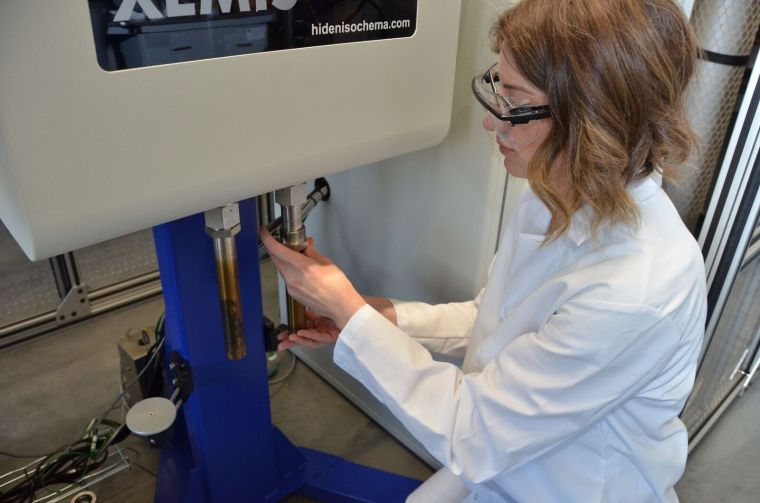Advanced Sorption analysis
Hiden Intelligent Gravimetric Analyzer
The Hiden Intelligent Gravimetric Analyzer (IGA) is a precision microbalance instrument designed to measure gas sorption in liquid and solid samples. The instrument accurately measures (P-x) vapor liquid equilibrium data and has the ability to measure the surface area and pore size of solid samples. Additionally, the IGA instrument is coupled with an in-line mass spectrometer to analyze volatile species during thermal decomposition studies. The various temperature options range from 20 degrees C to 1000 degrees C. The instrument has an operating pressure range between high vacuum (10-9 bar) to 20 bar with pressure control accurate to ± 0.001 bar. The instrument can operate with a sample loading as small as 50mg or as large as 5.0 grams. Potential application areas for the IGA include ionic liquids, food science, packaging materials and polymers, and refrigerant gases.
Hiden intelligent gravimetric sorption analyzer

The IGAsorp uses an ultrasensitive microbalance to accurately measure the weight of liquid and solid samples as the relative humidity and temperature of the enclosure are varied. It allows the study of vapor uptake and kinetics to characterize materials at specific conditions. This instrument features a large capacity balance with the ability to accommodate samples less than 5 g while measuring with 0.05 μg to 0.1 μg accuracy. It also has an isothermal control range of 5°C to 250°C ± 0.01 °C and high-precision control of water partial pressure (≤ 500 mbar) at ±01 %RH. The IGAsorp has potential applications in a wide range of fields, from polymers and textiles to packaging and construction materials.
XEMIS Gravimetric Microbalance

The XEMIS Gravimetric Microbalance was installed by Hiden Isochema (United Kingdom) and is fully operational since February 2017 in Dr. Shiflett’s lab. The XEMIS system is designed for studying a variety of applications including gas sorption analysis, kinetic analysis, hydrogen and methane storage, carbon dioxide sequestration, natural gas separation and purification. The system was designed by Hiden Isochema Engineers with Exosensing technology which allows operation with corrosive and flammable gases over a broad range in pressure (0 to 170 bar). The symmetric geometry of the system provides high precision and minimizes the buoyancy effects during the measurements. The various thermostat options (furnace, water bath, cryo cooling) allow measurements over a wide range in temperature from 77 K to 773 K. The system can handle both solid and liquid samples with a maximum weight of 5 g. The measurement capacity from 0 – 200 mg has an accuracy of 0.2 μg. A safety interlock system has been designed which allows for continuous unattended operation. The Shiflett Lab is the only academic lab in the United States and one of only six laboratories in the world which have a XEMIS gravimetric microbalance.
Gas Separation and Characterization
Pressure Swing Adsorption System for studying Natural Gas Purification

The PSA system is used to study the separation of contaminants such as N2, CO2, CO, and H2S from natural gas (NG). Shiflett lab group is currently working with Dr. David Corbin (Senior Scientist, CEBC) to develop new molecular sieves for the kinetic separation of N2, CO2, CO, and H2S from NG.
To remove contaminants, the natural gas is fed under pressure through a PSA column containing molecular sieve which can adsorb N2, CO2, CO, and H2S. After the sieve is saturated with N2, CO2, CO, or H2S, the flow is redirected to the next column and the first column is depressurized to desorb the N2, CO2, CO, and H2S and regenerate the sieve. In some cases the desorption is slower than the adsorption step, so multiple columns are needed to allow time for complete column regeneration. Development of a molecular sieve to remove N2, CO2, CO, and H2S from CH4 based on size difference is challenging because they only differ in size by 0.2 Angstroms (N2, CO2, CO, and H2S are about 3.4 to 3.6 Angstroms vs. CH4 is 3.8 Angstroms). However, if a molecular sieve can be developed for this application, it will significantly reduce the cost of separating inert gases such as N2, CO2, CO, and H2S and possibly He from NG. Current technologies, such as cryogenic plants for N2 removal, are complex and have high capital and operating costs compared to using a PSA system. The PSA technology is also field deployable, modular and can be scaled out to meet the capacity of the gas field.
Gas Chromatography Mass spectrometry

The Shiflett Lab is equipped with a suite of eight gas chromatographs configured with a range of detectors including: flame ionization, thermal conductivity, and mass spectrometry. Additionally, the lab has a diverse array of GC columns which can be used for select applications.


You must be logged in to post a comment.